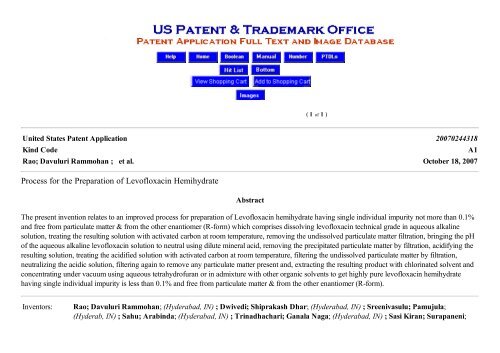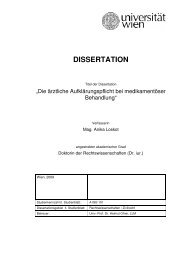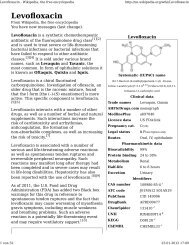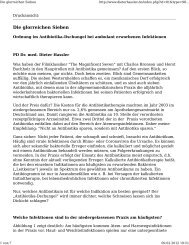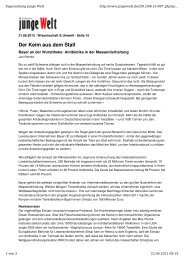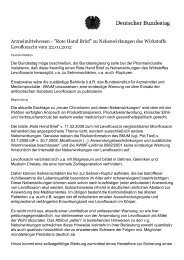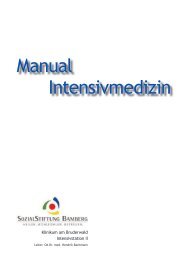Process for the Preparation of Levofloxacin Hemihydrate
Process for the Preparation of Levofloxacin Hemihydrate
Process for the Preparation of Levofloxacin Hemihydrate
Create successful ePaper yourself
Turn your PDF publications into a flip-book with our unique Google optimized e-Paper software.
( 1 <strong>of</strong> 1 )<br />
United States Patent Application 20070244318<br />
Kind Code<br />
Rao; Davuluri Rammohan ; et al. October 18, 2007<br />
<strong>Process</strong> <strong>for</strong> <strong>the</strong> <strong>Preparation</strong> <strong>of</strong> Lev<strong>of</strong>loxacin <strong>Hemihydrate</strong><br />
Abstract<br />
The present invention relates to an improved process <strong>for</strong> preparation <strong>of</strong> Lev<strong>of</strong>loxacin hemihydrate having single individual impurity not more than 0.1%<br />
and free from particulate matter & from <strong>the</strong> o<strong>the</strong>r enantiomer (R<strong>for</strong>m) which comprises dissolving lev<strong>of</strong>loxacin technical grade in aqueous alkaline<br />
solution, treating <strong>the</strong> resulting solution with activated carbon at room temperature, removing <strong>the</strong> undissolved particulate matter filtration, bringing <strong>the</strong> pH<br />
<strong>of</strong> <strong>the</strong> aqueous alkaline lev<strong>of</strong>loxacin solution to neutral using dilute mineral acid, removing <strong>the</strong> precipitated particulate matter by filtration, acidifying <strong>the</strong><br />
resulting solution, treating <strong>the</strong> acidified solution with activated carbon at room temperature, filtering <strong>the</strong> undissolved particulate matter by filtration,<br />
neutralizing <strong>the</strong> acidic solution, filtering again to remove any particulate matter present and, extracting <strong>the</strong> resulting product with chlorinated solvent and<br />
concentrating under vacuum using aqueous tetrahydr<strong>of</strong>uran or in admixture with o<strong>the</strong>r organic solvents to get highly pure lev<strong>of</strong>loxacin hemihydrate<br />
having single individual impurity is less than 0.1% and free from particulate matter & from <strong>the</strong> o<strong>the</strong>r enantiomer (R<strong>for</strong>m).<br />
A1<br />
Inventors:<br />
Rao; Davuluri Rammohan; (Hyderabad, IN) ; Dwivedi; Shiprakash Dhar; (Hyderabad, IN) ; Sreenivasulu; Pamujula;<br />
(Hyderab, IN) ; Sahu; Arabinda; (Hyderabad, IN) ; Trinadhachari; Ganala Naga; (Hyderabad, IN) ; Sasi Kiran; Surapaneni;
Correspondence<br />
Address:<br />
Serial No.: 578078<br />
Series Code: 10<br />
(Hyderabad, IN)<br />
Filed: August 11, 2004<br />
PCT Filed: August 11, 2004<br />
PCT NO:<br />
MOORE & VAN ALLEN PLLC<br />
P.O. BOX 13706<br />
Research Triangle Park<br />
NC<br />
27709<br />
US<br />
PCT/IN04/00343<br />
371 Date: March 7, 2007<br />
Current U.S. Class: 544/101<br />
Class at Publication: 544/101<br />
International Class:<br />
C07D 491/14 20060101 C07D491/14<br />
Claims<br />
1. An improved process <strong>for</strong> preparation <strong>of</strong> Lev<strong>of</strong>loxacin hemihydrate having single individual impurity not more than 0.1% and free from particulate<br />
matter and from <strong>the</strong> o<strong>the</strong>r enantiomer (R<strong>for</strong>m) which comprises i. dissolving lev<strong>of</strong>loxacin technical grade in aqueous alkaline solution, ii. treating <strong>the</strong><br />
resulting solution with activated carbon at room temperature, iii. removing <strong>the</strong> undissolved particulate matter filtration, iv. bringing <strong>the</strong> pH <strong>of</strong> <strong>the</strong> aqueous<br />
alkaline lev<strong>of</strong>loxacin solution to neutral using dilute mineral acid, v. removing <strong>the</strong> precipitated particulate matter by filtration, vi. acidifying <strong>the</strong> resulting<br />
solution, vii. treating <strong>the</strong> acidified solution with activated carbon at room temperature, viii. filtering <strong>the</strong> undissolved particulate matter by filtration, iv.<br />
neutralizing <strong>the</strong> acidic solution, x. filtering again to remove any particulate matter present and, xi. extracting <strong>the</strong> resulting product with chlorinated solvent<br />
and concentrating under vacuum using aqueous tetrahydr<strong>of</strong>uran or in admixture with o<strong>the</strong>r organic solvents to get highly pure lev<strong>of</strong>loxacin hemihydrate<br />
having single individual impurity less than 0.1% and free from particulate matter and from <strong>the</strong> o<strong>the</strong>r enantiomer (R<strong>for</strong>m).
2. An improved process as claimed in claim 1 wherein <strong>the</strong> filtration in steps (viii) and (x) may be effected using a 0.2 micron filter.<br />
3. An improved process as claimed in claim 1 wherein <strong>the</strong> alkaline Lev<strong>of</strong>loxacin solution is stirred at a pH in <strong>the</strong> range <strong>of</strong> 8.0 to 12.0, preferably 10.0<br />
12.0, more preferably 11.011.5.<br />
4. An improved process as claimed in claim 1 wherein <strong>the</strong> alkali used is selected from sodium hydroxide or potassium hydroxide, preferably sodium<br />
hydroxide and <strong>the</strong> concentration <strong>of</strong> <strong>the</strong> solution is 5 to 20% preferably 810%.<br />
5. An improved process as claimed in claim 1 wherein <strong>the</strong> pH is brought to 7.07.5 using dilute hydrochloric acid, preferably 0.5N to 5N hydrochloric<br />
acid, more preferably 1N hydrochloric acid.<br />
6. An improved process as claimed in claim 1 wherein <strong>the</strong> precipitated particulate matter is filtered and <strong>the</strong> pH is adjusted to 3.06.0 preferably 4.0 to 5.5<br />
more preferably 4.55.0 using glacial acetic acid.<br />
7. An improved process as claimed in claim 1 wherein <strong>the</strong> aqueous acidic lev<strong>of</strong>loxacin solution is treated with activated carbon at room temperature and<br />
<strong>the</strong> clear solution is filtered <strong>the</strong> pH to neutral preferably 7.07.5 using dilute aqueous ammonia solution.<br />
8. An improved process as claimed in claim 1 wherein <strong>the</strong> neutral aqueous solution is again filtered and extracted with chlorinated solvent preferably<br />
methylene chloride.<br />
9. An improved process as claimed in claim 1 wherein <strong>the</strong> extract is concentrated under vacuum (600650 mm <strong>of</strong> Hg) below 40.degree. C. and <strong>the</strong><br />
resulting residue is concentrated after stirring with tetrahydr<strong>of</strong>uran or its mixture with any o<strong>the</strong>r ano<strong>the</strong>r organic solvent.<br />
10. An improved process as claimed in claim 1 wherein <strong>the</strong> residue is slurred with 15% aqueous tetrahydr<strong>of</strong>uran preferably with 22.5% aqueous<br />
tetrahydr<strong>of</strong>uran.<br />
11. An improved process as claimed in claim 1 wherein <strong>the</strong> slurring with tetrahydr<strong>of</strong>uran is effected at 4070.degree. C. preferably at 5060.degree. C.<br />
more preferably at 5860.degree. C.<br />
12. An improved process as claimed in claim 1 wherein <strong>the</strong> slurring with tetrahydr<strong>of</strong>uran is effected <strong>for</strong> a period in <strong>the</strong> range <strong>of</strong> 30 minutes to 2 hours<br />
preferably 30 minutes to 1 hour and <strong>the</strong>n cooled to 5 to 15.degree. C. preferably 05.degree. C. and stirred <strong>for</strong> 30 minutes to 2 hours preferably 1 hour to
1 hour 30 minutes.<br />
13. An improved process as claimed in claim 1 wherein <strong>the</strong> product is filtered and suck dried <strong>for</strong> 15 minutes to 1 hour preferably 30 minutes to 45<br />
minutes and <strong>the</strong> product was dried at 5080.degree. C. preferably at 7075.degree. C. <strong>for</strong> 2 to 7 hours preferably 46 hours more preferably 5 to 5 hours<br />
30 minutes.<br />
14. An improved process <strong>for</strong> <strong>the</strong> preparation <strong>of</strong> Lev<strong>of</strong>loxacin hemihydrate which comprises, i. Converting 2,3,4,5tetrafluoro benzoic acid to its acid<br />
chloride by conventional method to give <strong>the</strong> diethyl2,3,4,5tetrafluoro benzoyl malonate, ii. Partially hydrolyzing and decarboxylating <strong>the</strong> resulting<br />
diethyl2,3,4,5tetrafluoro benzoyl malonate by conventional methods to give ethyl2,3,4,5tetrafluoro benzoyl acetate, iii. Converting <strong>the</strong> ethyl2,3,4,5<br />
tetrafluoro benzoyl acetate by known methods to ethyl2(2,3,4,5tetrafluoro benzoyl)3ethoxy acrylate, iv. Condensing <strong>the</strong> ethyl2(2,3,4,5tetrafluoro<br />
benzoyl)3ethoxy acrylate obtained in step (iii) with (S)2amino1propanol in a solvent, to give ethyl2(2,3,4,5tetrafluorobenzoyl)3[(1<br />
hydroxyprop2(S)yl)amino]acry late, v. Cyclising <strong>the</strong> resulting ethyl2(2,3,4,5tetrafluorobenzoyl)3[(1hydroxyprop2(S)yl)amino]acry late by<br />
conventional methods to give (S)ethyl9,10difluoro2,3dihydro3methyl7oxo7Hpyrido[12,3de]1, 4benzoxazine6carboxylate and, vi. fur<strong>the</strong>r<br />
hydrolyzing (S)ethyl9,10difluoro2,3dihydro3methyl7oxo7Hpyrido[1,2,3de]1 ,4benzoxazine6carboxylate, obtained in step (v) by known<br />
methods to give (S)9,10difluoro2,3dihydro3methyl7oxo7Hpyrido[1,2,3de]1, 4benzoxazine6carboxylic acid (namely Lev<strong>of</strong>loxacin Qacid),<br />
vii. converting <strong>the</strong> Lev<strong>of</strong>loxacin QAcid by condensing with Nmethyl piperazine by using solvent or without using solvent by any known methods to<br />
(S)9fluoro3methyl10(4methyl1piperazinyl)7oxo2,3dihydro7Hpy rido[1,2,3de]1,4benzoxazine6carboxylic acid (namely Lev<strong>of</strong>loxacin<br />
technical), viii. dissolving lev<strong>of</strong>loxacin technical in aqueous alkaline solution, ix. treating <strong>the</strong> resulting solution with activated carbon at room temperature,<br />
x. removing <strong>the</strong> undissolved particulate matter by filtration, xi. bringing <strong>the</strong> pH <strong>of</strong> <strong>the</strong> aqueous alkaline lev<strong>of</strong>loxacin solution to neutral using dilute<br />
mineral acid, xii. removing <strong>the</strong> precipitated particulate matter by filtration, xiii. acidifying <strong>the</strong> resulting solution, xiv. treating <strong>the</strong> acidified solution with<br />
activated carbon at room temperature, xv. filtering <strong>the</strong> undissolved particulate matter by filtration, xvi. neutralizing <strong>the</strong> acidic solution, xvii. filtering again<br />
to remove any particulate matter present and, xviii. extracting <strong>the</strong> resulting product with chlorinated solvent and concentrating under vacuum using<br />
aqueous tetrahydr<strong>of</strong>uran or in admixture with o<strong>the</strong>r organic solvents to get highly pure lev<strong>of</strong>loxacin hemihydrate having single individual impurity not<br />
more than 0.1% and free from particulate matter and from <strong>the</strong> o<strong>the</strong>r enantiomer (R<strong>for</strong>m).<br />
15. An improved process as claimed in claim 14 wherein in step (i), Diethyl malonate is acylated using 2,3,4,5tetrafluoro benzoyl chloride in <strong>the</strong><br />
presence <strong>of</strong> magnesium, ethanol by making diethyl ethoxymagnesiomalonate.<br />
16. An improved process as claimed in claim 14 wherein in step (ii) <strong>the</strong> conversion is effected using an aqueous medium employing catalytic amount <strong>of</strong><br />
para toluene sulfonic acid.<br />
17. An improved process as claimed in claim 14 wherein in <strong>the</strong> reagents used <strong>for</strong> <strong>the</strong> condensation in step (iii) is triethyl ortho<strong>for</strong>mate and acetic
anhydride.<br />
18. An improved process as claimed in claim 14 wherein <strong>the</strong> solvent used in step (iv) is methylene chloride.<br />
19. An improved process as claimed in claim 14 wherein <strong>the</strong> cyclisation in step (v) is done in <strong>the</strong> presence <strong>of</strong> suitable base such as potassium carbonate<br />
and an aprotic solvent such as N,Ndimethyl <strong>for</strong>mamide.<br />
20. An improved process as claimed in claim 14 wherein <strong>the</strong> hydrolysis in step (vi) is carried out using acetic acid and dilute hydrochloric acid.<br />
21. An improved process as claimed in claim 14 wherein, <strong>the</strong> condensation in step (vii) is carried out ei<strong>the</strong>r using aprotic solvent or without using solvent.<br />
22. An improved process as claimed in claim 21 wherein, <strong>the</strong> aprotic solvent which is used <strong>for</strong> condensation is pyridine.<br />
23. An improved process as claimed in claim 14 wherein <strong>the</strong> filtration in steps (xv) and (xvii) may be effected using a 0.2 micron filter.<br />
24. An improved process as claimed in claim 14 wherein <strong>the</strong> alkaline Lev<strong>of</strong>loxacin solution is stirred at a pH in <strong>the</strong> range <strong>of</strong> 8.0 to 12.0, preferably 10.0<br />
12.0, more preferably 11.011.5.<br />
25. An improved process as claimed in claim 14 wherein <strong>the</strong> alkali used in step (viii) is selected from sodium hydroxide or potassium hydroxide,<br />
preferably sodium hydroxide and <strong>the</strong> concentration <strong>of</strong> <strong>the</strong> solution is 5 to 20% preferably 810%.<br />
26. An improved process as claimed in claim 14 wherein <strong>the</strong> pH is brought to 7.07.5 using dilute hydrochloric acid, preferably 0.5N to 5N hydrochloric<br />
acid, more preferably 1N hydrochloric acid.<br />
27. An improved process as claimed in claim 14 wherein <strong>the</strong> precipitated particulate matter is filtered and <strong>the</strong> pH is adjusted to 3.06.0 preferably 4.0 to<br />
5.5 more preferably 4.55.0 using glacial acetic acid.<br />
28. An improved process as claimed in claim 14 wherein <strong>the</strong> aqueous acidic lev<strong>of</strong>loxacin solution is treated with activated carbon at room temperature<br />
and <strong>the</strong> clear solution is filtered <strong>the</strong> pH to neutral preferably 7.07.5 using dilute aqueous ammonia solution.<br />
29. An improved process as claimed in claim 14 wherein <strong>the</strong> neutral aqueous solution is again filtered and extracted with chlorinated solvent preferably<br />
methylene chloride.
30. An improved process as claimed in claim 14 wherein <strong>the</strong> extract is concentrated under vacuum (600650 mm <strong>of</strong> Hg) below 40.degree. C. and <strong>the</strong><br />
resulting residue is concentrated after stirring with tetrahydr<strong>of</strong>uran or its mixture with ano<strong>the</strong>r organic solvent.<br />
31. An improved process as claimed in claim 14 wherein <strong>the</strong> residue is slurred with 15% aqueous tetrahydr<strong>of</strong>uran preferably with 22.5% aqueous<br />
tetrahydr<strong>of</strong>uran.<br />
32. An improved process as claimed in claim 14 wherein <strong>the</strong> slurring with tetrahydr<strong>of</strong>uran is effected at 4070.degree. C. preferably at 5060.degree. C.<br />
more preferably at 5860.degree. C.<br />
33. An improved process as claimed in claim 14 wherein <strong>the</strong> slurring with tetrahydr<strong>of</strong>uran is effected <strong>for</strong> a period in <strong>the</strong> range <strong>of</strong> 30 minutes to 2 hours<br />
preferably 30 minutes to 1 hour and <strong>the</strong>n cooled to 5 to 15.degree. C. preferably 05.degree. C. and stirred <strong>for</strong> 30 minutes to 2 hours preferably 1 hour to<br />
1 hour 30 minutes.<br />
34. An improved process as claimed in claim 14 wherein <strong>the</strong> product is filtered and suck dried <strong>for</strong> 15 minutes to 1 hour preferably 30 minutes to 45<br />
minutes and <strong>the</strong> product was dried at 5080.degree. C. preferably at 7075.degree. C. <strong>for</strong> 2 to 7 hours preferably 46 hours more preferably 5 to 5 hours<br />
30 minutes.<br />
35. An improved process <strong>for</strong> <strong>the</strong> preparation <strong>of</strong> Lev<strong>of</strong>loxacin hemihydrate having single individual impurity not more than 0.1% and free from particulate<br />
matter and from <strong>the</strong> o<strong>the</strong>r enantiomer (R<strong>for</strong>m) from Lev<strong>of</strong>loxacin technical.<br />
36. An improved process <strong>for</strong> <strong>the</strong> preparation <strong>of</strong> Lev<strong>of</strong>loxacin hemihydrate having single individual impurity not more than 0.1% and free from particulate<br />
matter and from <strong>the</strong> o<strong>the</strong>r enantiomer (R<strong>for</strong>m) from 2,3,4,5tetrafluoro benzoic acid.<br />
Description<br />
FIELD OF INVENTION<br />
[0001] This invention provides an improved process <strong>for</strong> <strong>the</strong> preparation <strong>of</strong> Lev<strong>of</strong>loxacin hemihydrate. More specially, <strong>the</strong> invention provides an<br />
improved process <strong>for</strong> <strong>the</strong> preparation <strong>of</strong> high purity Lev<strong>of</strong>loxacin hemihydrate from Lev<strong>of</strong>loxacin technical. The Lev<strong>of</strong>loxacin hemihydrate prepared has<br />
a single individual impurity less than 0.1% free from particulate matter and o<strong>the</strong>r enantiomer (R<strong>for</strong>m). Lev<strong>of</strong>loxacin hemihydrate prepared by <strong>the</strong> process
<strong>of</strong> <strong>the</strong> present invention is useful as an antibacterial. The invention also relates to an improved process <strong>for</strong> <strong>the</strong> preparation <strong>of</strong> Lev<strong>of</strong>loxacin hemihydrate<br />
starting from 2,3,4,5,tetrafluoro benzoic acid through <strong>the</strong> intermediates Lev<strong>of</strong>loxacin Q acid and Lev<strong>of</strong>loxacin technical.<br />
BACKGROUND OF THE INVENTION<br />
[0002] Lev<strong>of</strong>loxacin is <strong>the</strong> S() isomer <strong>of</strong> <strong>the</strong> fluoroquinoline antibacterial Ofloxacin. Lev<strong>of</strong>loxacin is generally considered to be about twice as active as<br />
Ofloxacin. It has a broad spectrum <strong>of</strong> activity, which included Grampositive bacteria. [Davis R, Bryson H M, Drugs, 4, 677(1994)]. Lev<strong>of</strong>loxacin is<br />
given by mouth or intravenously <strong>for</strong> <strong>the</strong> treatment <strong>of</strong> susceptible infections in a usual dose <strong>of</strong> 250 or 500 mg. once or twice daily. It is also administered<br />
topically as 0.5% eye drops <strong>for</strong> <strong>the</strong> treatment <strong>of</strong> bacteria conjunctivitis [Martindale, The Complete Drug Reference, 33.sup.rd edition, pp. 219 (2002) and<br />
references cited <strong>the</strong>rein].<br />
[0003] The Lev<strong>of</strong>loxacin hemihydrate is (S)9Fluoro2,3dihydro3methyl10(4methyl1piperazinyl)7oxo7Hpyr ido[1,2,3de]1,4benzoxazine6<br />
carboxylic acid hemihydrate. The chemical structure <strong>of</strong> Lev<strong>of</strong>loxacin hemihydrate (CAS Registry No. [138199710]) is shown as <strong>for</strong>mula I. ##STR1##<br />
[0004] U.S. Pat. No. 5,545,737 and EP patent No. 0444678 disclose a process <strong>for</strong> <strong>the</strong> preparation <strong>of</strong> lev<strong>of</strong>loxacin hemihydrate or monohydrate<br />
selectively by controlling <strong>the</strong> water content <strong>of</strong> an aqueous solvent selected from <strong>the</strong> group consisting <strong>of</strong> methanol, ethanol, propanol and acetone in which<br />
lev<strong>of</strong>loxacin is dissolved during crystallization.<br />
[0005] Niddamhil Desheim, Valeric et al. disclose in WO 03/045329, and in WO 03/028665, methods <strong>for</strong> <strong>the</strong> purification <strong>of</strong> Lev<strong>of</strong>loxacin using polar<br />
solvent such as DMSO, methyl ethyl ketone, acetonitrile, butanol and mixtures <strong>the</strong>re<strong>of</strong> and aqueous mixture <strong>the</strong>re<strong>of</strong> and/or using an antioxidant.<br />
[0006] Lev<strong>of</strong>loxacin was first disclosed in U.S. Pat. No. 5,053,407 and in Antimicrob. Agents chemo<strong>the</strong>r. 29, 163 (1986) by Hayakawa I, et al. In this<br />
process 9,10Difluoro3(hydroxymethyl)7oxo2,3dihydro7Hpyrido[1,2,3fi?e]1 ,4benzoxazine6carboxylic acid ethyl ester, a racemic<br />
intermediate in <strong>the</strong> syn<strong>the</strong>sis <strong>of</strong> Ofloxacin was resolved and esterified with 3,5dinitro benzoyl chloride, separated by HPLC column SUMIPAXOA<br />
4200, using hexane, 1,2dichloro ethane, ethanol as carrier solvent. The () optical isomer is partially hydrolyzed with ethanolic aqueous sodium<br />
bicarbonate to af<strong>for</strong>d <strong>the</strong> () alcohol, which is treated with triphenyl phosphite methiodide in DMF giving <strong>the</strong> corresponding ()iodomethyl derivative.<br />
The reduction and simultaneous hydrolysis with tributyltin hydride in ethanol yield ()9,10difluoro3methyl7oxo2,3dihydro7Hpyrido[1,2,3Je]1,4<br />
benzoxazine6carboxylic acid which is finally treated with Nmethyl piperazine at 120.degree. C. in DMSO to give () Ofloxacin i.e. Lev<strong>of</strong>loxacin.<br />
[0007] In U.S. Pat. No. 5,053,407 racemic3acetoxy methyl7,8difluoro2,3dihydro4H[1,4]benzoxazine was resolved through its dinitrobenzoyl<br />
derivatives (or condensed with a cyclic amino acid or a reactive derivative through amide linkage) followed by debenzoylation, deacylation and<br />
dehydroxylation to obtained optically active 7,8difluoro2,3dihydro3methyl4H[1,4]benzoxazine which on condensation with diethyl ethoxy
acrylomalonate followed by cyclization, hydrolysis and condensation with Nmethyl piperazine to obtain Lev<strong>of</strong>loxacin.<br />
[0008] Scientists <strong>of</strong> Daiichi prepared <strong>the</strong> intermediate ()9,10difluoro3methyl7oxo2.sub.53dihydro7Hpyrido[1,2,3de]1,4 benzoxazine6<br />
carboxylic acid by ei<strong>the</strong>r resolution or chiral specific syn<strong>the</strong>sis. While condensation with Nmethyl piperazine major reports disclosed in <strong>the</strong> presence <strong>of</strong><br />
DMSO at above 100.degree. C. or chilation with BF.sub.3OEt.sub.2 in e<strong>the</strong>r and <strong>the</strong>n condensation with Nmethyl piperazine in <strong>the</strong> presence <strong>of</strong><br />
DMSO, triethylamine has reported.<br />
[0009] The preparation <strong>of</strong> Lev<strong>of</strong>loxacin has also been reported in U.S. Pat. No. 4,777,253 and J. Med. Chem. 30, 2283 (1987) by Mitcher et al.<br />
Lev<strong>of</strong>loxacin syn<strong>the</strong>sized from 2,3,4,5tetrafluoro benzoic acid which is treated with thionyl chloride to produce <strong>the</strong> corresponding acid chloride.<br />
Displacement <strong>of</strong> <strong>the</strong> acid chloride with malonic acid half ester in <strong>the</strong> presence <strong>of</strong> nButyl lithium yield <strong>the</strong> .beta.ketoester. The .beta.ketoester is <strong>the</strong>n<br />
treated with a trialkyl ortho<strong>for</strong>mate in <strong>the</strong> presence <strong>of</strong> an acid anhydride yielding Ethyl2(2,3,4,5tetrafluoro benzoyl)3alkoxy acylate, which on<br />
reaction with (S)2amino1propanol to obtain enamino ketoester. The enamino ketoester is <strong>the</strong>n cyclized such as by treatment with two moles<br />
equivalents <strong>of</strong> an alkali metal hydride, alkoxide at an elevated temperature to obtain alkyl()9,10difluoro.about.3methyl7oxo2,3dihydro7Hpyrido<br />
[1,2,3 afe]1,4benzoxazine6carboxylate. The condensation reaction between Nmethyl piperazine and alkyl ()9,10difluoro3methyl7oxo2,3<br />
dihydro7Hpyrido[1,2,3fe]1,4benzo xazine6carboxylate at temperature from 20.degree. C. to 200.degree. C. and preferably from 40.degree. C. to<br />
90.degree. C. in <strong>the</strong> presence <strong>of</strong> a suitable organic solvent such as pyridine, chloro<strong>for</strong>m, dimethylsulphoxide, sulfolane, dimethyl<strong>for</strong>mamide,<br />
dimethylacetamide, 1methyl2Pyrrolidone. It is desirable to carry out <strong>the</strong> reaction in <strong>the</strong> presence <strong>of</strong> an acidacceptor such as triethyl amine, potassium<br />
carbonate and <strong>the</strong> like a molar ratio <strong>of</strong> 1.0 to 1.2 mole <strong>of</strong> <strong>the</strong> acidacceptor per mole <strong>of</strong> <strong>the</strong> ester. Nmethyl piperazine can also be used as an acidacceptor<br />
in which two or more molar excess is used.<br />
[0010] Antons, Stefan et al. Bayer. A.G. have reported in German patent no DE 4428020A, a process <strong>for</strong> <strong>the</strong> preparation <strong>of</strong> ()9,10difluoro2,3<br />
dihydro(S)3methyl7oxo7Hpyrido[1,2,3de]1,4 benzoxazine6carboxylic acid starting from 2,3,4,5tetrafluoro benzoyl chloride. The process<br />
comprises condensing 2,3,4,5tetrafluoro benzoyl chloride with ei<strong>the</strong>r 3(Nmethyl piperazinyl)acetylic acrylic acid ethyl ester or 3(N,Ndimethylamino)acetylic<br />
acrylic acid ethyl ester followed by transamination with (S)2Amino propanol, cyclization and hydrolysis.<br />
[0011] Schriewer et al. Bayer A.G. has disclosed in U.S. Pat. No. 5,237,060 a process <strong>of</strong> preparing enantiomerically pure 1,8bridged4quinolone3<br />
carboxylic acids, starting from 3ethoxy2(2,3,4,5tetrafluoro benzoyl) acrylic acid ethyl ester. 3ethoxy2(2,3,4,5tetrafluoro benzoyl) acrylic acid ethyl<br />
ester on condensation with (S)2amino propanol, cyclization using potassium carbonate, hydrolysis and condensation with Nmethylpiperazine provides<br />
Lev<strong>of</strong>loxacin.<br />
[0012] Kim et al. <strong>of</strong> Korea Institute <strong>of</strong> Science and Technology reported in U.S. Pat. No. 5,539,110 a method <strong>for</strong> <strong>the</strong> preparation <strong>of</strong> () piperazine<br />
derivative. The () 9,10Difluoro2.sub.53dihydro3methyl7oxo7/?pyrido[1,2,3 ]1,4benzoxazine6carboxylic acid is prepared starting from (S)
(+)2Amino1propanol in four steps by condensing with alkyl silylated piperazine in <strong>the</strong> presence <strong>of</strong> organic polar solvent such as pyridine,<br />
dimethylsulfoxide, acetonitrile, dimethyl<strong>for</strong>mamide, Nmethyl pyrrolidine and sulfolane.<br />
[0013] Juan. C. Carretero et al. in Heterocycles vol 51, No 7, 1999; have also published an efficient syn<strong>the</strong>sis <strong>of</strong> Ofloxacin and Lev<strong>of</strong>loxacin from 3,4<br />
difluoroaniline. Key steps in <strong>the</strong> syn<strong>the</strong>tic sequence are <strong>the</strong> regioselective functionalization at ei<strong>the</strong>r C2 or C3 <strong>of</strong> <strong>the</strong> N(tertbutoxy carbonyl)3,4,<br />
difluoroaniline and <strong>the</strong> construction <strong>of</strong> <strong>the</strong> benzoxazine skeleton by Oalkylation <strong>of</strong> <strong>the</strong> corresponding phenol with propylene oxide, which was<br />
trans<strong>for</strong>med into Ofloxacin or Lev<strong>of</strong>loxacin by condensing with Nmethyl piperazine. Shohgo Atarashi et al. in Chem. Pharm. Bull 35 (5) 18961902<br />
(1987). discloses, two optically active isomers <strong>of</strong> Ofloxacin and <strong>the</strong>ir fluoromethyl derivatives were prepared via <strong>the</strong>ir optically active intermediates<br />
resolved by used <strong>of</strong> high per<strong>for</strong>mance liquid chromatography (HPLC). The isomers were also obtained efficiently by an alternative route via separation<br />
<strong>of</strong> <strong>the</strong> diastereo isomers prepared in <strong>the</strong> reaction <strong>of</strong> benzoxazine with Lproline chloride, <strong>the</strong>n condensation <strong>of</strong> Nmethyl piperazine with ()9,10<br />
difluoro2,3dihydro(S)3methyl7oxo7i/pyrido[1,2,3de]1, 4benzoxazine6carboxylic acid in <strong>the</strong> presence <strong>of</strong> dimethyl sulphoxide.<br />
[0014] Carretero Gonzalver et al. <strong>of</strong> in U.S. Pat. No. 5,521,310 disclose a process <strong>for</strong> <strong>the</strong> preparation <strong>of</strong> benzoxazines which is to be used <strong>for</strong> <strong>the</strong><br />
syn<strong>the</strong>sis <strong>of</strong> Lev<strong>of</strong>loxacin Ofloxacin and derivatives starting from 3,4difluoroaniline.<br />
[0015] Nakamura, Hiroshi et al. in JP patent no 2001 31,654. according to <strong>the</strong> process disclosed in this patent Ethyl 6,7,8trifluoro1,4dihydro1(1<br />
acetoxymethyl)ethyl4oxoquinoline3car boxylate is prepared and condensed with 1methyl piperazine in toluene at 100.degree. C. <strong>for</strong> 2 hrs and <strong>the</strong>n<br />
cyclized in <strong>the</strong> presence <strong>of</strong> sodium hydroxide in 2propanol at 100.degree. C. <strong>for</strong> 2 hrs.<br />
[0016] Lev<strong>of</strong>loxacin disclosed recently in Zhonggno Yaowu Huaxue Zazhi 2000, 10 (4), 276278 (Ch) by Li, Jiaming et al. from 2,3,4,5tetrafluoro<br />
benzoic acid by chlorination, condensation with diEt malonate, partial hydrolysis, decarboxylation, condensation with triethyl ortho<strong>for</strong>mate, substitution<br />
with (S)(+)2aminopropanol, cyclization, hydrolysis and substitution with Nmethyl piperazine.<br />
[0017] In view <strong>of</strong> <strong>the</strong> need <strong>for</strong> <strong>the</strong> Lev<strong>of</strong>loxacin hemihydrate having single individual impurity not more than 0.1% and free from particulate matter <strong>for</strong><br />
pharmaceutical applications, we under took R&D work towards this direction.<br />
[0018] Accordingly, <strong>the</strong> main objective <strong>of</strong> <strong>the</strong> present invention is to provide an improved process <strong>for</strong> <strong>the</strong> preparation <strong>of</strong> Lev<strong>of</strong>loxacin hemihydrate<br />
having single individual impurity not more than 0.1% and free from particulate matter & from <strong>the</strong> o<strong>the</strong>r enantiomer (R<strong>for</strong>m).<br />
[0019] Yet ano<strong>the</strong>r objective <strong>of</strong> <strong>the</strong> present invention is to provide an improved process <strong>for</strong> <strong>the</strong> preparation <strong>of</strong> Lev<strong>of</strong>loxacin hemihydrate by dissolving<br />
Lev<strong>of</strong>loxacin in water at different pH followed by filtration and using aqueous tetrahydr<strong>of</strong>uran <strong>for</strong> making <strong>the</strong> Lev<strong>of</strong>loxacin hemihydrate.
[0020] Still ano<strong>the</strong>r objective <strong>of</strong> <strong>the</strong> present invention is to provide an improved process <strong>for</strong> <strong>the</strong> preparation <strong>of</strong> Lev<strong>of</strong>loxacin hemihydrate starting from<br />
2,3,4,5/tetrafluoro benzoic acid through <strong>the</strong> intermediates Lev<strong>of</strong>loxacin Qacid and Lev<strong>of</strong>loxacin technical.<br />
SUMMARY OF THE INVENTION<br />
[0021] Accordingly, <strong>the</strong> present invention provides an improved process <strong>for</strong> preparation <strong>of</strong> Lev<strong>of</strong>loxacin hemihydrate having single individual impurity<br />
not more than 0.1% and free from particulate matter & from <strong>the</strong> o<strong>the</strong>r enantiomer (R<strong>for</strong>m) which comprises [0022] (i) dissolving lev<strong>of</strong>loxacin technical<br />
grade in aqueous alkaline solution, [0023] (ii) treating <strong>the</strong> resulting solution with activated carbon at room temperature, [0024] (iii) removing <strong>the</strong><br />
undissolved particulate matter through filtration,<br />
[0025] (iv) bringing <strong>the</strong> pH <strong>of</strong> <strong>the</strong> aqueous alkaline lev<strong>of</strong>loxacin solution to neutral using dilute mineral acid, [0026] (v) removing <strong>the</strong> precipitated<br />
particulate matter by filtration, [0027] (vi) acidifying <strong>the</strong> resulting solution, [0028] (vii) treating <strong>the</strong> acidified solution with activated carbon at room<br />
temperature, [0029] (viii) filtering <strong>the</strong> undissolved particulate matter by filtration, [0030] (ix) neutralizing <strong>the</strong> acidic solution, [0031] (x) filtering again to<br />
remove any particulate matter present and [0032] (xi) extracting <strong>the</strong> resulting product with chlorinated solvent and concentrating under vacuum using<br />
aqueous tetrahydr<strong>of</strong>uran or in admixture with o<strong>the</strong>r organic solvents to get highly pure lev<strong>of</strong>loxacin hemihydrate having single individual impurity less<br />
than 0.1% and free from particulate matter & from <strong>the</strong> o<strong>the</strong>r enantiomer (R<strong>for</strong>m).<br />
[0033] In a preferred embodiment <strong>of</strong> <strong>the</strong> present invention <strong>the</strong> filtration in steps (viii) & (x) may be effected using a 0.2 micron filter.<br />
[0034] Lev<strong>of</strong>loxacin technical is prepared ei<strong>the</strong>r by using pyridine as a solvent or without using solvent by any known methods. Lev<strong>of</strong>loxacin technical<br />
may be stirred in water and pH is adjusted to 8.0 to 12.0, preferably 10.012.0, more preferably 11.011.5 with dilute alkali metal hydroxide solution,<br />
preferably 5 to 20% alkali solution, more preferably 810%. The alkali metal hydroxide which may be used may be ei<strong>the</strong>r sodium hydroxide or potassium<br />
hydroxide, preferably sodium hydroxide. The aqueous alkaline lev<strong>of</strong>loxacin solution is treated with activated carbon, and <strong>the</strong> clear solution is filtered.<br />
Then <strong>the</strong> pH is brought to 7.07.5 using dilute hydrochloric acid, preferably 0.5N to 5N hydrochloric acid, more preferably 1N hydrochloric acid. The<br />
precipitated particulate matter is filtered. Again <strong>the</strong> aqueous solution pH may be adjusted to 3.06.0 preferably 4.0 to 5.5 more preferably 4.55.0 using<br />
glacial acetic acid. The aqueous acidic lev<strong>of</strong>loxacin solution was treated with activated carbon at room temperature and <strong>the</strong> clear solution may be filtered<br />
preferably through micron filter. Finally <strong>the</strong> pH <strong>of</strong> <strong>the</strong> aqueous solution may be adjusted to neutral preferably 7.07.5 using dilute aqueous ammonia<br />
solution. The neutral aqueous solution may be again filtered preferably through micron filter and extracted with chlorinated solvent preferably methylene<br />
chloride. The extract may be concentrated under vacuum (600650 mm <strong>of</strong> Hg) below 40.degree. C. The resulting residue was concentrated after stirring<br />
with tetrahydr<strong>of</strong>uran or its mixture any o<strong>the</strong>r organic solvent. Finally <strong>the</strong> residue was slurred with 15% aqueous tetrahydr<strong>of</strong>uran preferably with 22.5%<br />
aqueous tetrahydr<strong>of</strong>uran at 4070.degree. C. preferably at 5060.degree. C. more preferably at 5860.degree. C. <strong>for</strong> 30 minutes to 2 hours preferably 30<br />
minutes to 1 hour <strong>the</strong>n cooled to 5 to 15.degree. C. preferably 05.degree. C. and stirred <strong>for</strong> 30 minutes to 2 hours preferably 1 hour to 1 hour 30
minutes. The product was filtered and suck dried <strong>for</strong> 15 minutes to 1 hour preferably 30 minutes to 45 minutes and <strong>the</strong> product was dried at 50<br />
80.degree. C. preferably at 7075.degree. C. <strong>for</strong> 2 to 7 hours preferably 46 hours more preferably 5 to 5 hours 30 minutes to give highly pure<br />
Lev<strong>of</strong>loxacin hemihydrate with single individual impurity less than 0.1%. Elemental analysis calculated <strong>for</strong><br />
C.sub.18H.sub.20FN.sub.3O.sub.4.1/2H.sub.2O is C 58.37%, H 5.71%, N 11.35%, and found is C 58.38%, H 5.67%, N 11.38%.<br />
[0035] The Xray diffraction pattern <strong>of</strong> <strong>the</strong> Lev<strong>of</strong>loxacin hemihydrate prepared by <strong>the</strong> process <strong>of</strong> <strong>the</strong> present invention is found to be identical to that <strong>of</strong><br />
<strong>the</strong> Lev<strong>of</strong>loxacin hemihydrate prepared by <strong>the</strong> process reported in U.S. Pat. No. 5, 545,737, EP patent 0444678 and Chem. Pharm. Bull, 43 (4) 649653<br />
(1995). The typical Xray diffraction pattern <strong>of</strong> <strong>the</strong> prepared Lev<strong>of</strong>loxacin hemihydrate is given below. TABLEUS00001 Angle d value Intensity 2<br />
Theta.sup.0 angstrom % 6.654 13.27346 100.0 9.704 9.10667 60.2 13.092 6.75695 38.5 13.360 6.62202 4.1 13.761 6.42997 2.2 14.744 6.00343 1.0<br />
15.833 5.59291 7.9 18.382 4.82260 1.3 19.918 4.68723 4.8 19.435 4.56359 13.0 20.037 4.42795 9.4 23.442 3.79187 1.6 24.222 3.67147 1.3 24.459<br />
3.63649 1.3 25.028 3.55510 2.4 25.819 3.44792 2.3 26.415 3.37141 6.5 26.743 3.33087 6.3 27.708 3.21699 1.0 28.979 3.07872 2.1 30.466 2.93177<br />
1.0 30.661 2.91353 1.3 31.456 2.84173 1.8 32.994 2.71263 1.1 34.468 2.59993 1.8 37.740 2.38172 1.0 40.480 2.22663 2.7 42.486 2.12601 2.0 44.042<br />
2.05443 1.0 45.337 1.99873 1.9<br />
[0036] According to ano<strong>the</strong>r embodiment <strong>of</strong> <strong>the</strong> present invention <strong>the</strong>re is provided an improved process <strong>for</strong> <strong>the</strong> preparation <strong>of</strong> Lev<strong>of</strong>loxacin hemihydrate<br />
which comprises [0037] (i) Converting 2,3,4,5tetrafluoro benzoic acid to its acid chloride by conventional method to give <strong>the</strong> diethyl2,3,4,5tetrafluoro<br />
benzoyl malonate. [0038] (ii) Partially hydrolyzing and decarboxylating <strong>the</strong> resulting diethyl2,3,4,5tetrafluoro benzoyl malonate by conventional<br />
methods to give ethyl2,3,4,5tetrafluoro benzoyl acetate. [0039] (iii) Converting <strong>the</strong> ethyl2,3,4,5tetrafluoro benzoyl acetate by known methods to ethyl<br />
2(2,3,4,5tetrafluoro benzoyl)3ethoxy acrylate. [0040] (iv) Condensing <strong>the</strong> ethyl2(2,3,4,5tetrafluoro benzoyl)3ethoxy acrylate obtained in step (iii)<br />
with (S)2amino1propanol in a solvent, to give ethyl2(2,3,4,5tetrafluoro benzoyl)3[(1hydroxyprop2(S)yl)amino]acrylate, [0041] (v) Cyclising<br />
<strong>the</strong> resulting ethyl2(2,3,4,5tetrafluoro benzoyl)3[(1hydroxy prop2(S)yl)amino]acrylate by conventional methods to give (S)ethyl9,10difluoro<br />
2,3dihydro3methyl7oxo7Hpyrido[1,2,3Je]1 ,4benzoxazine6carboxylate and, [0042] (vi) fur<strong>the</strong>r hydrolyzing (S)ethyl9,10difluoro2,3<br />
dihydro3methyl7oxo7Hpyrido[1,2,3de]1 ,4benzoxazine6carboxylate, obtained in step (v) by known methods to give (S)9,10difluoro2,3<br />
dihydro3methyl7oxo7Hpyrido[1,2,3fife] 1,4benzoxazine6carboxylic acid (namely Lev<strong>of</strong>loxacin Qacid), [0043] (vii) converting <strong>the</strong><br />
Lev<strong>of</strong>loxacin QAcid by condensing with Nmethyl piperazine by using solvent or without using solvent by any known methods to (S)9fluoro3<br />
methyl10(4methyl1piperazinyl)7oxo2,3dihydro7H pyrido[1,2,3cfe]1,4benzoxazine6carboxylic acid (namely Lev<strong>of</strong>loxacin technical),<br />
[0044] (viii) dissolving lev<strong>of</strong>loxacin technical in aqueous alkaline solution, [0045] (ix) treating <strong>the</strong> resulting solution with activated carbon at room<br />
temperature, [0046] (x) removing <strong>the</strong> undissolved particulate matter by filtration, [0047] (xi) bringing <strong>the</strong> pH <strong>of</strong> <strong>the</strong> aqueous alkaline lev<strong>of</strong>loxacin<br />
solution to neutral using dilute mineral acid, [0048] (xii) removing <strong>the</strong> precipitated particulate matter by filtration, [0049] (xiii) acidifying <strong>the</strong> resulting<br />
solution, [0050] (xiv) treating <strong>the</strong> acidified solution with activated carbon at room temperature, [0051] (xv) filtering <strong>the</strong> undissolved particulate matter by<br />
filtration, [0052] (xvi) neutralizing <strong>the</strong> acidic solution, [0053] (xvii) filtering again to remove any particulate matter present and, [0054] (xviii) extracting<br />
<strong>the</strong> resulting product with chlorinated solvent and concentrating under vacuum using aqueous tetrahydr<strong>of</strong>uran or in admixture with o<strong>the</strong>r organic solvents
to get highly pure lev<strong>of</strong>loxacin hemihydrate having single individual impurity not more than 0.1% and free from particulate matter & from <strong>the</strong> o<strong>the</strong>r<br />
enantiomer (R<strong>for</strong>m).<br />
[0055] Reaction sequence is shown in <strong>the</strong> scheme given below. ##STR2##<br />
[0056] In a preferred embodiment <strong>of</strong> <strong>the</strong> invention in step (i) , Diethyl malonate may be acylated using 2,3,4,5tetrafluoro benzoyl chloride in <strong>the</strong><br />
presence <strong>of</strong> magnesium, ethanol by making diethyl ethoxymagnesiomalonate.<br />
[0057] The reagents used <strong>for</strong> <strong>the</strong> condensation in step (iii) may be triethyl ortho<strong>for</strong>mate and acetic anhydride.<br />
[0058] In step (ii) <strong>the</strong> conversion may be effected using an aqueous medium employing catalytic amount <strong>of</strong> para toluene sulfonic acid.<br />
[0059] An example <strong>of</strong> <strong>the</strong> solvent used in step (iv) may be methylene chloride.<br />
[0060] The cyclisation in step (v) may be done in <strong>the</strong> presence <strong>of</strong> suitable base such as potassium carbonate and an aprotic solvent such as N,Ndimethyl<br />
<strong>for</strong>mamide.<br />
[0061] The hydrolysis in step (vi) may be carried out using acetic acid and dilute hydrochloric acid.<br />
[0062] The details <strong>of</strong> <strong>the</strong> present invention are described in <strong>the</strong> following examples which are provided only to illustrate <strong>the</strong> invention and <strong>the</strong>re<strong>for</strong>e<br />
should not be construed to limit <strong>the</strong> scope <strong>of</strong> <strong>the</strong> invention.<br />
EXAMPLE1<br />
<strong>Preparation</strong> <strong>of</strong> ()9fluoro3methyl10(4methyl1piperazinyl)7oxo2,3dihydro7fIPV rJdO [1,2,,3,
micron Millipore filter paper. To <strong>the</strong> clear filtrate, aqueous ammonia solution was added to get pH 7.07.5. Filtered <strong>the</strong> solution over 0.2 micron Millipore<br />
filter paper. The product was extracted with methylene chloride (3.times.550 ml). Distilled <strong>of</strong>f combined methylene chloride layer under reduced pressure<br />
below 40.degree. C. temperature. Charged 50 ml tetrahydr<strong>of</strong>uran and codistilled <strong>the</strong> methylene chloride. 22.5% aqueous tetrahydr<strong>of</strong>uran (150 ml) was<br />
charged into <strong>the</strong> flask and heated to gentle reflux temperature (5860.degree. C.). Maintained <strong>the</strong> reaction mixture under <strong>the</strong> conditions <strong>for</strong> 30 minutes,<br />
cooled <strong>the</strong> contents <strong>of</strong> <strong>the</strong> flask to 0.degree. C., kept <strong>for</strong> 1 hour at 05.degree. C. Filtered <strong>the</strong> product and washed <strong>the</strong> product with chilled 22.5%<br />
aqueous tetrahydr<strong>of</strong>uran (50 ml), suck dried <strong>for</strong> 15 minutes. Dried <strong>the</strong> product at 7075.degree. C., to constant weight. The yield was 34.0 g. HPLC<br />
purity 99.82% and single individual impurity less than 0.1%. Moisture content: Calculated <strong>for</strong> Lev<strong>of</strong>loxacin hemihydrate was 2.43% and found is 2.45%.<br />
Elemental analysis: calculated <strong>for</strong> C.sub.18H.sub.20FN.sub.3O.sub.4. vz H.sub.2O is C 58.37%, H 5.71%, N 11.35% and found is C 58.38%, H 5.67%<br />
and N 11.38%.<br />
EXAMPLE2<br />
<strong>Preparation</strong> <strong>of</strong> ()9f uoro3methyI10(4methyl1piperazinyl)7oxo2,3dihyd ro7flpyrido [1,2,3,
EXAMPLE 3<br />
<strong>Preparation</strong> <strong>of</strong> ()9fluoro3methyI10f4methyl1piperazinyI)7oxo2,3dihydr(>7/ /PVrJdO [1,2,,3
salt solution (200 g <strong>of</strong> vacuum salt with 1 L DM water) followed by DM water (500 ml) washing. The aqueous layer <strong>of</strong> DM water washing was checked<br />
<strong>for</strong> sulfate test (sulfates should be absent). If sulfates were present, again <strong>the</strong> organic layer was washed with DM water (500 ml) till sulfates were absent.<br />
Organic layer was concentrated under vacuum (550650 mm/Hg) up to mass temperature 80.degree. C. to give quantitative yield <strong>of</strong> diethyl2,3,4,5<br />
tetrafluoro benzoyl malonate. HPLC purity: 98.35%.<br />
Step (iii) <strong>Preparation</strong> <strong>of</strong> ()Ethyl9q .<strong>the</strong>ta.difluoro23dihydro3methyl7oxo7.ffpyridofl,,2,3
material were charged into <strong>the</strong> flask. The contents <strong>of</strong> <strong>the</strong> flask were cooled to 05.degree. C. and maintained 30 minutes at 05.degree. C. Material was<br />
filtered and washed with 650 ml acetone. The material was dried at 7075.degree. C. to give 315 g ()ethyl9,10difluoro2,3dihydro3methyl7oxo<br />
7Hpyrido[1,2,3de]1 ,4benzoxazine6carboxylate. HPLC purity: 99.23.degree./{dot over (o)}.<br />
Step (iv) <strong>Preparation</strong> <strong>of</strong> M JODifluoro Jdihydro mett.Lyl oxoTffpyridofl.2,3de 11,4benzoxazine6carboxylic acid:<br />
[0069] Into a 1 L 3 neck round bottom flask equipped with mechanical stirrer, <strong>the</strong>rmometer socket and condenser, 125 ml water, 125 ml concentrated<br />
hydrochloric acid, 250 ml acetic acid and 100 g (0.32 mol) ()ethyl9,10difluoro2,3dihydro3methyl7oxo7H pyrido [1,2,3cfe]1,4benzoxazine6<br />
carboxylate were charged. The contents were heated to 7580.degree. C. and maintained <strong>for</strong> 6 hrs at 7580.degree. C. After 6 hrs <strong>the</strong> conversion <strong>of</strong><br />
reaction was monitored by TLC. The reaction mixture was cooled to 1520.degree. C. and maintained <strong>for</strong> 1 hr. at 1520.degree. C. Material was filtered<br />
and washed with water. Wet material was slurred with water at 4550.degree. C. and filtered. Dried at 7080.degree. C. to give 80 g <strong>of</strong> ()9,10difluoro<br />
2,3dihydro3methyl7oxo7Hpyrido[1,2,3de]1,4benzo xazine6carboxylic acid. HPLC purity: 99.33%.<br />
Step (v) <strong>Preparation</strong> <strong>of</strong> (V9fluoro3methyl10(4methyl1piperazinvIV7oxo2,3dihydro7//pyri do ri,2,3,de11,4benzoxazine6carboxylic acid<br />
(Lev<strong>of</strong>loxacin Technical):<br />
[0070] Into a 3 necked round bottom flask equipped with a mechanical stirrer, <strong>the</strong>rmometer socket and a condenser, 228 g (2.28 mol) Nmethyl<br />
piperazine, 1.2 L pyridine and 200 g (0.712 mol) ()9,10difluoro2,3dihydro3methyl7oxo7Hpyrido[1,2,3de]1,4benz oxazine6carboxylic acid<br />
are charged <strong>the</strong> contents are heated to reflux at 120.degree. C. <strong>for</strong> 10 hrs. and conversion is monitored by TLC. The reaction mixture is concentrated<br />
under vacuum (600650 mm <strong>of</strong> Hg) to leave residue, 200 ml methanol is charged and fur<strong>the</strong>r concentrated. 800 ml Methanol is charged to residue and<br />
heated to reflux <strong>for</strong> 30 min. reaction mass is cooled to 1015.degree. C. and maintained <strong>for</strong> 1 hour, material is filtered and washed with 100 ml chilled<br />
methanol to give 210 g <strong>of</strong> Lev<strong>of</strong>loxacin (technical) HPLC purity: 98.58%.<br />
Step (vi) <strong>Preparation</strong> <strong>of</strong> ()9fluoro3methyl10(4methyl1piperazinyl)7oxo2,3dihydro7Irpy rido fl,2,3,
extracted with methylene chloride (3.times.2.2 L). Distilled <strong>of</strong>f combined methylene chloride layer under reduced pressure below 40.degree. C.<br />
temperature. Charged 200 ml tetrahydr<strong>of</strong>uran and codistilled <strong>the</strong> methylene chloride. 22.5% aqueous tetrahydr<strong>of</strong>uran (600 ml) was charged into <strong>the</strong><br />
flask and heated to gentle reflux temperature (5860.degree. C.). Maintained <strong>the</strong> reaction mixture under <strong>the</strong> conditions <strong>for</strong> 30 minutes, cooled <strong>the</strong> contents<br />
<strong>of</strong> <strong>the</strong> flask to 0.degree. C., kept <strong>for</strong> 1 hour at 05.degree. C. Filtered <strong>the</strong> product and washed <strong>the</strong> product with chilled 22.5% aqueous tetrahydr<strong>of</strong>uran<br />
(200>ml), suck dried <strong>for</strong> 15 minutes. Dried <strong>the</strong> product at 7075.degree. C., to constant weight. The yield was 142 g. HPLC purity 99.90% and single<br />
individual impurity less than 0.1%. Moisture content: Calculated <strong>for</strong> Lev<strong>of</strong>loxacin hemihydrate was 2.43% and found is 2.50%. Elemental analysis:<br />
calculated <strong>for</strong> C.sub.18H.sub.20FN.sub.3O.sub.4.V.sub.2H.sub.2O is C 58.37%, H 5.71%, N 11.35% and found is C 58.35%, H 5.72% and N 11.38%.<br />
Advantages <strong>of</strong> <strong>the</strong> Present Invention<br />
[0072] (i) Lev<strong>of</strong>loxacin hemihydrate prepared having single individual impurity less than 0.1% and free from particulate matter. [0073] (ii) Lev<strong>of</strong>loxacin<br />
hemihydrate prepared is free from <strong>the</strong> o<strong>the</strong>r enantiomer (R<strong>for</strong>m). [0074] (iii) The process <strong>of</strong> <strong>the</strong> present invention provides industrially feasible process.<br />
[0075] (iv) The process is simple and safe and environmentally friendly<br />
[0076] It should be noted that <strong>the</strong> invention also envisages o<strong>the</strong>r embodiments falling within <strong>the</strong> scope <strong>of</strong> <strong>the</strong> present invention which will be obvious and<br />
apparent to one skilled in <strong>the</strong> art from <strong>the</strong> <strong>for</strong>egoing disclosure.<br />
* * * * *


